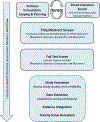Progress in data interoperability to support computational toxicology and chemical safety evaluation
- PMID: 31404555
- PMCID: PMC7705611
- DOI: 10.1016/j.taap.2019.114707
Progress in data interoperability to support computational toxicology and chemical safety evaluation
Abstract
New approach methodologies (NAMs) in chemical safety evaluation are being explored to address the current public health implications of human environmental exposures to chemicals with limited or no data for assessment. For over a decade since a push toward "Toxicity Testing in the 21st Century," the field has focused on massive data generation efforts to inform computational approaches for preliminary hazard identification, adverse outcome pathways that link molecular initiating events and key events to apical outcomes, and high-throughput approaches to risk-based ratios of bioactivity and exposure to inform relative priority and safety assessment. Projects like the interagency Tox21 program and the US EPA ToxCast program have generated dose-response information on thousands of chemicals, identified and aggregated information from legacy systems, and created tools for access and analysis. The resulting information has been used to develop computational models as viable options for regulatory applications. This progress has introduced challenges in data management that are new, but not unique, to toxicology. Some of the key questions require critical thinking and solutions to promote semantic interoperability, including: (1) identification of bioactivity information from NAMs that might be related to a biological process; (2) identification of legacy hazard information that might be related to a key event or apical outcomes of interest; and, (3) integration of these NAM and traditional data for computational modeling and prediction of complex apical outcomes such as carcinogenesis. This work reviews a number of toxicology-related efforts specifically related to bioactivity and toxicological data interoperability based on the goals established by Findable, Accessible, Interoperable, and Reusable (FAIR) Data Principles. These efforts are essential to enable better integration of NAM and traditional toxicology information to support data-driven toxicology applications.
Keywords: Applications; Bioinformatics; Computational Toxicology; Data Interoperability; Databases.
Copyright © 2019 Elsevier Inc. All rights reserved.
Figures



Similar articles
-
Computational toxicology as implemented by the U.S. EPA: providing high throughput decision support tools for screening and assessing chemical exposure, hazard and risk.J Toxicol Environ Health B Crit Rev. 2010 Feb;13(2-4):197-217. doi: 10.1080/10937404.2010.483935. J Toxicol Environ Health B Crit Rev. 2010. PMID: 20574897
-
The Next Generation Blueprint of Computational Toxicology at the U.S. Environmental Protection Agency.Toxicol Sci. 2019 Jun 1;169(2):317-332. doi: 10.1093/toxsci/kfz058. Toxicol Sci. 2019. PMID: 30835285 Free PMC article.
-
Advancing exposure characterization for chemical evaluation and risk assessment.J Toxicol Environ Health B Crit Rev. 2010 Feb;13(2-4):299-313. doi: 10.1080/10937404.2010.483947. J Toxicol Environ Health B Crit Rev. 2010. PMID: 20574904
-
Improving the human hazard characterization of chemicals: a Tox21 update.Environ Health Perspect. 2013 Jul;121(7):756-65. doi: 10.1289/ehp.1205784. Epub 2013 Apr 19. Environ Health Perspect. 2013. PMID: 23603828 Free PMC article. Review.
-
Aggregating data for computational toxicology applications: The U.S. Environmental Protection Agency (EPA) Aggregated Computational Toxicology Resource (ACToR) System.Int J Mol Sci. 2012;13(2):1805-1831. doi: 10.3390/ijms13021805. Epub 2012 Feb 9. Int J Mol Sci. 2012. PMID: 22408426 Free PMC article. Review.
Cited by
-
Current state of data stewardship tools in life science.Front Big Data. 2024 Sep 16;7:1428568. doi: 10.3389/fdata.2024.1428568. eCollection 2024. Front Big Data. 2024. PMID: 39351001 Free PMC article. Review.
-
Weight of evidence for cross-species conservation of androgen receptor-based biological activity.Toxicol Sci. 2023 May 31;193(2):131-145. doi: 10.1093/toxsci/kfad038. Toxicol Sci. 2023. PMID: 37071731 Free PMC article.
-
The ECOTOXicology Knowledgebase: A Curated Database of Ecologically Relevant Toxicity Tests to Support Environmental Research and Risk Assessment.Environ Toxicol Chem. 2022 Jun;41(6):1520-1539. doi: 10.1002/etc.5324. Epub 2022 Apr 26. Environ Toxicol Chem. 2022. PMID: 35262228 Free PMC article.
-
Correlation Analysis of Variables From the Atherosclerosis Risk in Communities Study.Front Pharmacol. 2022 Jul 11;13:883433. doi: 10.3389/fphar.2022.883433. eCollection 2022. Front Pharmacol. 2022. PMID: 35899108 Free PMC article.
-
Capturing a Comprehensive Picture of Biological Events From Adverse Outcome Pathways in the Drug Exposome.Front Public Health. 2021 Dec 17;9:763962. doi: 10.3389/fpubh.2021.763962. eCollection 2021. Front Public Health. 2021. PMID: 34976924 Free PMC article.
References
-
- Richard AM et al. ToxCast Chemical Landscape: Paving the Road to 21st Century Toxicology. Chem Res Toxicol 29, 1225–1251 (2016). - PubMed
-
- Egeghy PP et al. The exposure data landscape for manufactured chemicals. Sci Total Env. 414, 159–166 (2012). - PubMed
-
- Shimkus JM Frank R Lautenberg Chemical Safety for the 21st Century Act. United States Statutes at Large 448–513 (2014).
-
- National Research Council. Toxicity Testing in the 21st Century: A Vision and a Strategy. (The National Academies Press, 2007). doi:doi:10.17226/11970 - DOI
Publication types
MeSH terms
Substances
Grants and funding
LinkOut - more resources
Full Text Sources
Research Materials

